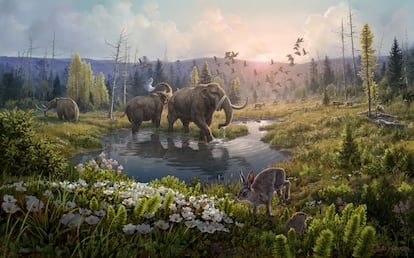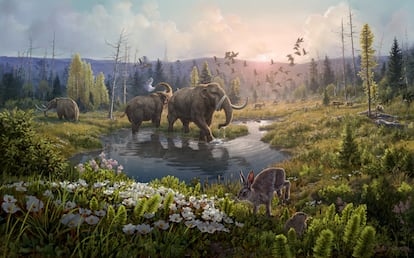World’s oldest known DNA reveals a once-lush paradise in the Arctic
Ancient genetic material recovered from soil samples marks a new era in natural history research

Greenland’s Kap København is so far north that it directly faces the North Pole. This land formation is now what is called a polar desert. For most of the year, it’s covered in ice that nourishes the lichens and mosses growing on the rocks. Scientists recently discovered that two million years ago, this area was a lush paradise where hundreds of species flourished among birch, poplar and pine forests. Aromatic, flowering plants similar to roses grew wild. Mice, lemmings and rabbits thrived on the abundant flora, as did larger herbivores similar to the reindeer of today. There were even megaherbivores, the now-extinct mastodons. Surprisingly, no fossils have been found. All the evidence of biodiversity found in this now-inhospitable area comes from DNA recovered from soil samples.
The natural history of the Earth is being rewritten as increasingly older genetic material is discovered. DNA is a fragile material that deteriorates when exposed to environmental forces like erosion, enzyme action, temperature, pressure and oxidation. The most well-preserved DNA samples have been found in fossilized teeth and bones. Scientific advances in DNA recovery and sequencing techniques over the last two decades have also facilitated the analysis of older samples. Twenty years ago, scientists thought it impossible to recover DNA that was more than 100,000 years old. But a decade ago, Spanish scientists extracted mitochondrial DNA (inside the cell, but outside the cell nucleus) from humans who inhabited the Atapuerca area in northern Spain 400,000 years ago. In 2013, the genome of a horse ancestor that lived 700,000 years ago was sequenced. Just last year, scientists extracted genetic information from mammoths preserved in the Siberian permafrost for more than a million years. The DNA found at Kap København is twice as old, dating back 1.9-2.1 million years. And it was found in the soil, not fossils.

A scientific paper on the environmental DNA discovery was recently published in Nature by a team led by Eske Willerslev, a researcher with the University of Cambridge (UK) and the director of the Center for GeoGenetics at the University of Copenhagen (Denmark). “This is the longest project I’ve ever participated in. We started in 2006 when we first went to Greenland to collect samples,” he said in an online presentation for journalists. They explored the coastal moors of Kap København using traditional paleontology techniques, and found only a few dozen pollen grains and a single fossil from a hare or rabbit. But they didn’t find any fossils from which they could extract DNA. They preserved various layers of soil hoping that they could get some information out of them in the future when scientific techniques advanced sufficiently. “Every time there were improvements in [genetic material] extraction methods and sequencing technologies, we would go back to the soil samples, but we failed and failed, and failed again,” said Willerslev. Then, a few years ago, everything changed.
We explored some new areas, such as how DNA adheres to mineralsKarina Sand, Center for GeoGenetics, University of Copenhagen (Denmark)
For the past five years, several scientific societies have been studying ways of extracting genetic information from an organism’s environment, not from the organism itself. It’s a new tool of paleoecology that uses sedimentary ancient DNA (sedaDNA). Karina Sand, an associate professor at the University of Copenhagen and a co-author of the Nature study, said, “We explored some new areas, such as how DNA adheres to minerals.” Once the organism to which it belonged has decomposed, genetic material attaches to the substrate. Some sediments are able to absorb more DNA than others. “For example, clay minerals can preserve DNA much better than quartz minerals,” said Sand. But clay absorbs DNA so well, it becomes very difficult to extract. Finding genetic material in the geological substrate is a breakthrough in itself, but the capacity to extract and analyze it is even more remarkable.
Antonio Fernández Guerra, who also works with the Center for GeoGenetics and co-authored the study, described what it was like to work with the environmental DNA discovered at Kap København. “It enabled us to imagine what the area was like two million years ago. A forest full of trees and plants, and streams that carried all kinds of material to the sea. At the mouths of these streams, we found concentrations of DNA, especially from plants. DNA from animals was more difficult to identify. But any organism living on the coast two million years ago was also in the environmental DNA. Every sample used in genetic sequencing contained a lot of bacteria and archaea [microorganisms], so we had to filter out all that noise to find the DNA. Sometimes only one in a million sequences was valid.”
As they looked for needles in haystacks, the research team identified the genus of more than 100 plants. Genus is one of the scientific categories for organizing life (in hierarchical order: domain, kingdom, phylum, class, order, family, genus and species). Identifying individual species in environmental DNA that is two million years ago isn’t easy, but the research team was able to identify specific trees, such as the Arctic willow and the dwarf birch. They had a more difficult time identifying animals. Every ecosystem has fewer animals than plants, so they logically identified less animal DNA and were unable to identify animals below the family or genus level. But they did find genetic remains of vertebrates that still exist in Greenland, such as the Nearctic lemming and the Arctic hare. The research team also identified the genus of fleas, ants and some extinct elephant and reindeer ancestors.
No DNA of carnivorous animals has been found, which makes sense considering that the number of species dwindles as you go up the food chain. But Willersley and his team believe that there must have been wolves, bears and even saber-toothed tigers, just like in other Arctic ecosystems. “Obviously, plants are more common than herbivores, and herbivores are more common than carnivores,” said Willersley. “That’s probably why we haven’t found any carnivores. However, if we keep sampling and sequencing, I predict that we will find carnivores at some point.”
What’s fascinating is that we are able to identify species in ecosystems without having any fossil evidenceDavid Díez del Molino, Center for Paleogenetics, Stockholm, Sweden
David Díez del Molino, a researcher with the Center for Paleogenetics (Stockholm, Sweden) is one of the scientists who recovered DNA from mammoths that lived a million years ago. While he didn’t participate in the Kap København study, he is enthused about the future promise of the innovative techniques they used. “Sedimentary ancient DNA [sedaDNA]is one of the hottest topics and most promising fields in paleogenetics right now,” said Díez del Molino. “It enables us to reconstruct the DNA of an entire ecosystem, which is virtually impossible using only DNA from bones and other materials.” But he notes one weakness in sedaDNA. “The amount of DNA recovered from each species is quite small compared to bone DNA, which limits us to only rudimentary analyses.” Díez del Molino says they only used three samples from the mammoth molars and were able to recover millions of nuclear sequences. This enabled them to perform complex phylogenetic analyses and discover previously unknown mammoth lineages. Nevertheless, he says, “What’s fascinating is that we are able to identify species in ecosystems without having any fossil evidence.”
Sign up for our weekly newsletter to get more English-language news coverage from EL PAÍS USA Edition
Tu suscripción se está usando en otro dispositivo
¿Quieres añadir otro usuario a tu suscripción?
Si continúas leyendo en este dispositivo, no se podrá leer en el otro.
FlechaTu suscripción se está usando en otro dispositivo y solo puedes acceder a EL PAÍS desde un dispositivo a la vez.
Si quieres compartir tu cuenta, cambia tu suscripción a la modalidad Premium, así podrás añadir otro usuario. Cada uno accederá con su propia cuenta de email, lo que os permitirá personalizar vuestra experiencia en EL PAÍS.
¿Tienes una suscripción de empresa? Accede aquí para contratar más cuentas.
En el caso de no saber quién está usando tu cuenta, te recomendamos cambiar tu contraseña aquí.
Si decides continuar compartiendo tu cuenta, este mensaje se mostrará en tu dispositivo y en el de la otra persona que está usando tu cuenta de forma indefinida, afectando a tu experiencia de lectura. Puedes consultar aquí los términos y condiciones de la suscripción digital.
More information
Últimas noticias
Sinaloa Cartel war is taking its toll on Los Chapitos
Venezuela hardens its ‘revolutionary state’ project amid pressure from Trump
Sydney Sweeney, the actress praised by Trump: ‘Women are up against what society wants them to be’
The Bolsonaro surname: An advantage or liability in Brazil’s 2026 presidential elections?
Most viewed
- Reinhard Genzel, Nobel laureate in physics: ‘One-minute videos will never give you the truth’
- Pablo Escobar’s hippos: A serious environmental problem, 40 years on
- Charles Dubouloz, mountaineering star, retires at 36 with a farewell tour inspired by Walter Bonatti
- Why we lost the habit of sleeping in two segments and how that changed our sense of time
- The fall of a prolific science journal exposes the billion-dollar profits of scientific publishing










































